Alfa Romeo 147 2010 Owner handbook (in English)
Manufacturer: ALFA ROMEO, Model Year: 2010, Model line: 147, Model: Alfa Romeo 147 2010Pages: 291, PDF Size: 5.52 MB
Page 41 of 291

GETTING TO KNOW YOUR CAR
39
IMPORTANTIn the event of side crash,
you can obtain the best protection by the
system keeping a correct position on the
seat, thus allowing correct window bag un-
folding.
IMPORTANTThe front and/or side air
bags may be activated if the car is subjected
to heavy shocks or accidents that involve the
underbody area, such as for example violent
bumps against steps, pavements or fixed ob-
stacles on the ground, falling into big holes
or bumpy roads.IMPORTANTThe triggering of air bags
releases a small amount of powder. This pow-
der is not harmful and does not indicate a
start of fire; also the surfaces of the deployed
bag and the car interior may be covered with
dusty residue: this may irritate the skin and
eyes. In the event of exposure, wash with
neutral soap and water.
The airbag system has a validity of 14
years for the pyrotechnic charge and 10
years for the coil contact (see the plate lo-
cated on the front left door near the lock).
Contact Alfa Romeo Authorized Services for
replacement as these dates approach.
IMPORTANTIf an accident has trig-
gered the air bag, Alfa Romeo Authorized
Services must be contacted to have the de-
vices activated replaced and to have the
whole system checked.All operations involving checking, repair-
ing and replacing components concerning
the Air bag must be carried out by Alfa
Romeo Authorized Services.
If the car is to be demolished, Alfa Romeo
Authorized Services should be contacted be-
forehand to have the system deactivated.
If the car changes ownership, the new
owner must be informed of the instructions
for use and of the above warnings and be
given this “Owner’s Manual“.
IMPORTANTThe triggering of the pre-
tensioners, front air bags and side bags is
decided by the electronic control unit in a
differentiated manner depending on the type
of crash. The failure to trigger one or more
of them does not necessarily indicate a sys-
tem malfunction.
Never rest head, arms and
elbows on the door, on the
windows and in the window bag
area to prevent possible injuries
during the inflation phase.
WARNING
Never lean head, arms and
elbows out of the window.
WARNING
Page 42 of 291
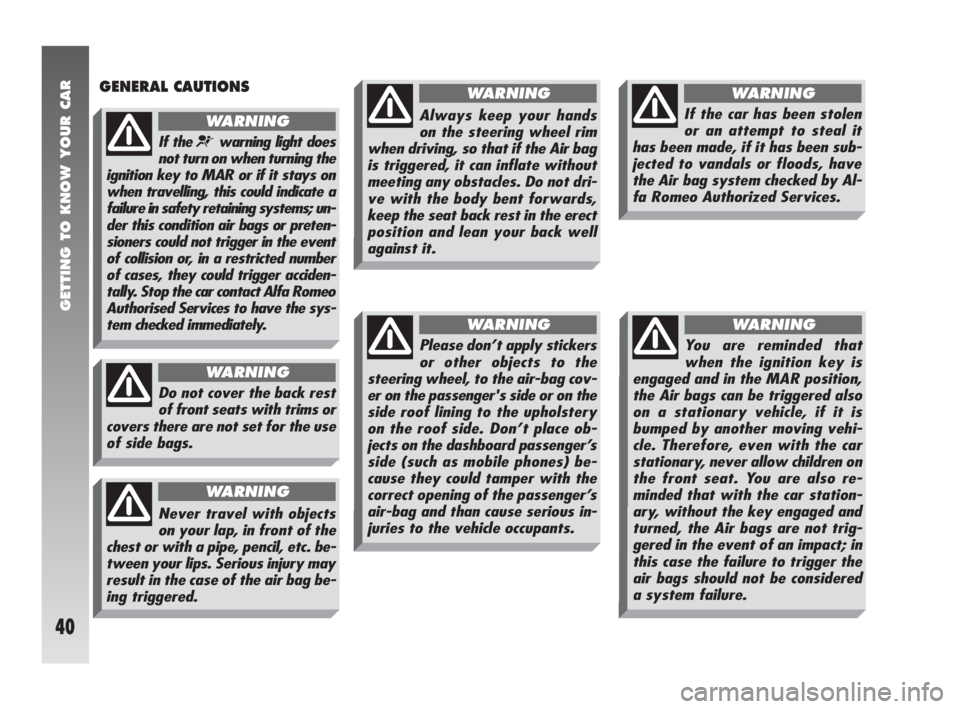
GETTING TO KNOW YOUR CAR
40
GENERAL CAUTIONS
You are reminded that
when the ignition key is
engaged and in the MAR position,
the Air bags can be triggered also
on a stationary vehicle, if it is
bumped by another moving vehi-
cle. Therefore, even with the car
stationary, never allow children on
the front seat. You are also re-
minded that with the car station-
ary, without the key engaged and
turned, the Air bags are not trig-
gered in the event of an impact; in
this case the failure to trigger the
air bags should not be considered
a system failure.
WARNING
Do not cover the back rest
of front seats with trims or
covers there are not set for the use
of side bags.
WARNING
If the ¬warning light does
not turn on when turning the
ignition key to MAR or if it stays on
when travelling, this could indicate a
failure in safety retaining systems; un-
der this condition air bags or preten-
sioners could not trigger in the event
of collision or, in a restricted number
of cases, they could trigger acciden-
tally. Stop the car contact Alfa Romeo
Authorised Services to have the sys-
tem checked immediately.
WARNING
Never travel with objects
on your lap, in front of the
chest or with a pipe, pencil, etc. be-
tween your lips. Serious injury may
result in the case of the air bag be-
ing triggered.
WARNING
If the car has been stolen
or an attempt to steal it
has been made, if it has been sub-
jected to vandals or floods, have
the Air bag system checked by Al-
fa Romeo Authorized Services.
WARNING
Always keep your hands
on the steering wheel rim
when driving, so that if the Air bag
is triggered, it can inflate without
meeting any obstacles. Do not dri-
ve with the body bent forwards,
keep the seat back rest in the erect
position and lean your back well
against it.
WARNING
Please don’t apply stickers
or other objects to the
steering wheel, to the air-bag cov-
er on the passenger's side or on the
side roof lining to the upholstery
on the roof side. Don’t place ob-
jects on the dashboard passenger’s
side (such as mobile phones) be-
cause they could tamper with the
correct opening of the passenger’s
air-bag and than cause serious in-
juries to the vehicle occupants.
WARNING
Page 43 of 291
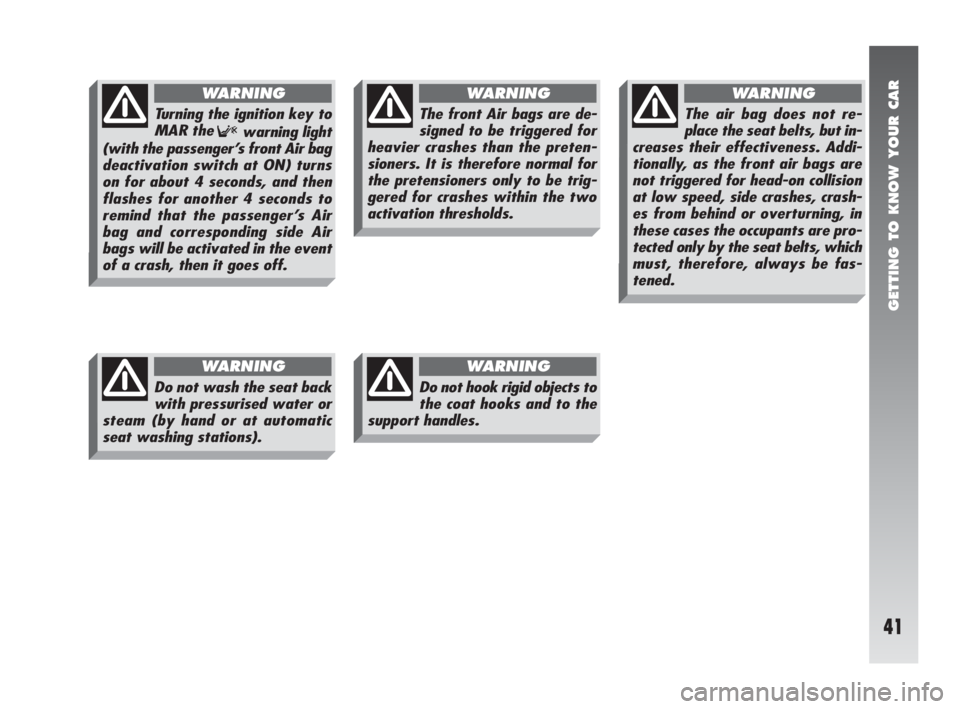
GETTING TO KNOW YOUR CAR
41
Turning the ignition key to
MAR the
Fwarning light
(with the passenger’s front Air bag
deactivation switch at ON) turns
on for about 4 seconds, and then
flashes for another 4 seconds to
remind that the passenger’s Air
bag and corresponding side Air
bags will be activated in the event
of a crash, then it goes off.
WARNING
Do not hook rigid objects to
the coat hooks and to the
support handles.
WARNING
Do not wash the seat back
with pressurised water or
steam (by hand or at automatic
seat washing stations).
WARNING
The front Air bags are de-
signed to be triggered for
heavier crashes than the preten-
sioners. It is therefore normal for
the pretensioners only to be trig-
gered for crashes within the two
activation thresholds.
WARNING
The air bag does not re-
place the seat belts, but in-
creases their effectiveness. Addi-
tionally, as the front air bags are
not triggered for head-on collision
at low speed, side crashes, crash-
es from behind or overturning, in
these cases the occupants are pro-
tected only by the seat belts, which
must, therefore, always be fas-
tened.
WARNING
Page 44 of 291

GETTING TO KNOW YOUR CAR
42
STEERING
WHEEL LEVERS
The devices and services controlled by the
levers on the steering wheel can only be ac-
tivated with the ignition key at MAR.
LEFT-HAND LEVER
The left-hand lever controls the outer lights
except the fog lamps and rear fog guards.
When the outer lights are switched on, the
various controls on the dashboard are illu-
minated.
Only with the ignition key at PARK, re-
gardless of the position of the knurled ring,
the side lights and number plate lights stay
on.
Position (1or2-fig. 57) of the lever
causes the turning on only of the side lights
(front and rear), on the right or left respec-
tively.
Lights switched off (fig. 52)
When the pointer on the knurled ring is op-
posite the symbol Othe outer lights are
switched off.Sidelights(fig. 53)
The sidelights are switched on by turning
the knurled ring from Oto
6.
The
3warning light on the instrument
cluster will come on at the same time.
Dipped-beam headlights (fig. 54)
These are switched on by turning the
knurled ring from
6to2.
fig. 52
A0A0063m
fig. 53
A0A0064m
Main beams (fig. 55)
To turn main beams on, set knurled ring
to position
2, push the lever towards the
dashboard (stable position); warning light
1on the instrument panel will turn on.
To set dipped-beams back pull the lever to-
wards the steering wheel.
fig. 54
A0A0065m
fig. 55
A0A0066m
Page 45 of 291
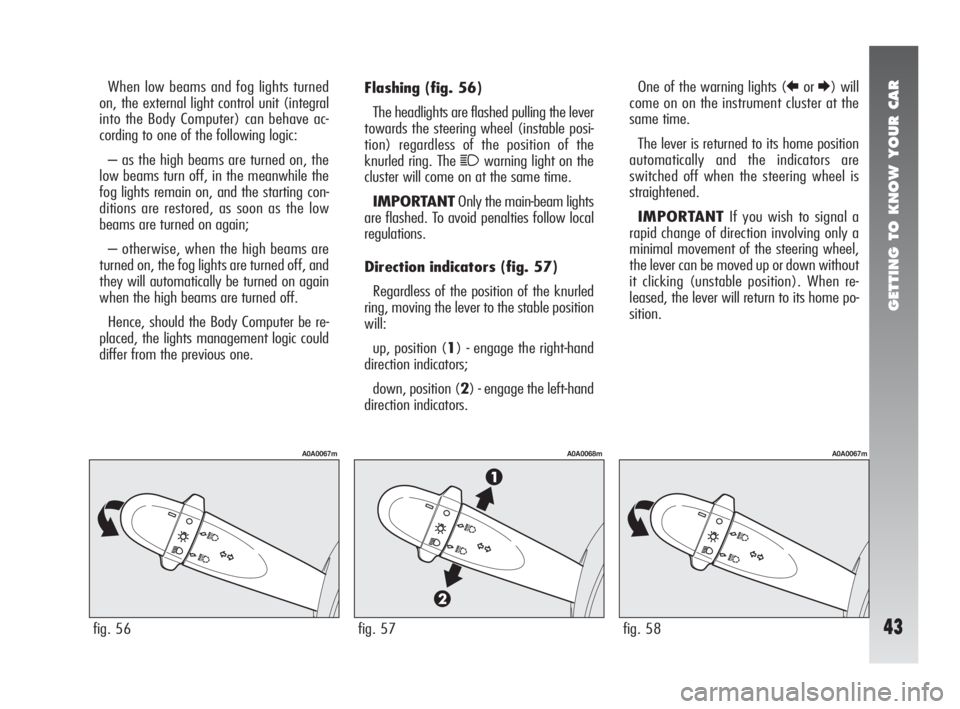
GETTING TO KNOW YOUR CAR
43
Flashing(fig. 56)
The headlights are flashed pulling the lever
towards the steering wheel (instable posi-
tion) regardless of the position of the
knurled ring. The
1warning light on the
cluster will come on at the same time.
IMPORTANTOnly the main-beam lights
are flashed. To avoid penalties follow local
regulations.
Direction indicators (fig. 57)
Regardless of the position of the knurled
ring, moving the lever to the stable position
will:
up, position (1) - engage the right-hand
direction indicators;
down, position (2) - engage the left-hand
direction indicators.One of the warning lights (
RorE) will
come on on the instrument cluster at the
same time.
The lever is returned to its home position
automatically and the indicators are
switched off when the steering wheel is
straightened.
IMPORTANTIf you wish to signal a
rapid change of direction involving only a
minimal movement of the steering wheel,
the lever can be moved up or down without
it clicking (unstable position). When re-
leased, the lever will return to its home po-
sition. When low beams and fog lights turned
on, the external light control unit (integral
into the Body Computer) can behave ac-
cording to one of the following logic:
– as the high beams are turned on, the
low beams turn off, in the meanwhile the
fog lights remain on, and the starting con-
ditions are restored, as soon as the low
beams are turned on again;
– otherwise, when the high beams are
turned on, the fog lights are turned off, and
they will automatically be turned on again
when the high beams are turned off.
Hence, should the Body Computer be re-
placed, the lights management logic could
differ from the previous one.
fig. 56
A0A0067m
fig. 58
A0A0067m
fig. 57
A0A0068m
Page 46 of 291
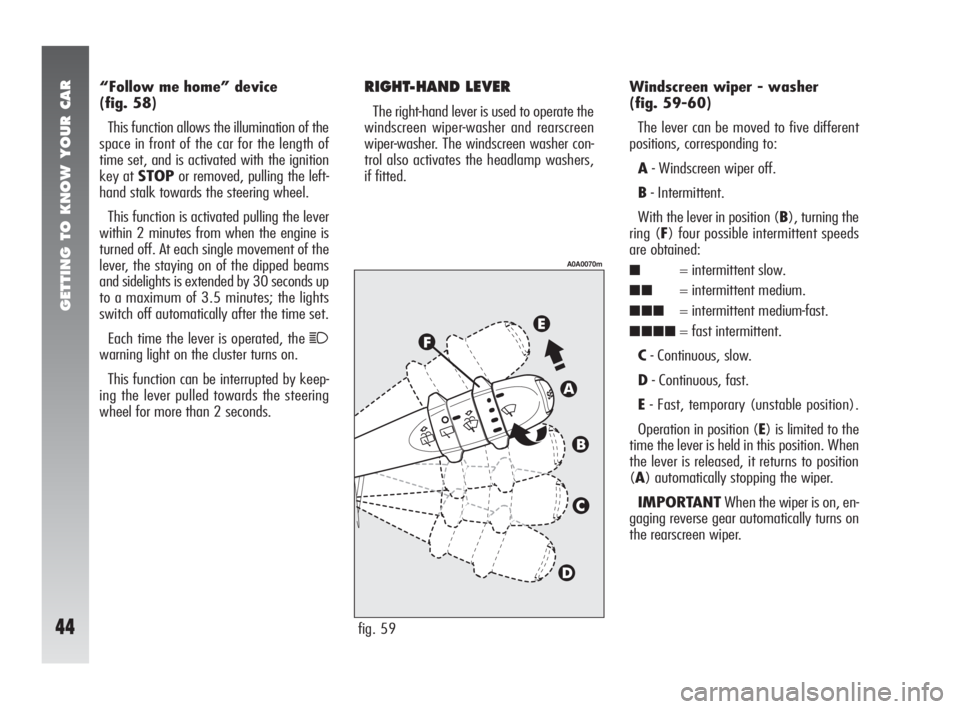
GETTING TO KNOW YOUR CAR
44
“Follow me home” device
(fig. 58)
This function allows the illumination of the
space in front of the car for the length of
time set, and is activated with the ignition
key at STOPor removed, pulling the left-
hand stalk towards the steering wheel.
This function is activated pulling the lever
within 2 minutes from when the engine is
turned off. At each single movement of the
lever, the staying on of the dipped beams
and sidelights is extended by 30 seconds up
to a maximum of 3.5 minutes; the lights
switch off automatically after the time set.
Each time the lever is operated, the
1
warning light on the cluster turns on.
This function can be interrupted by keep-
ing the lever pulled towards the steering
wheel for more than 2 seconds.
RIGHT-HAND LEVER
The right-hand lever is used to operate the
windscreen wiper-washer and rearscreen
wiper-washer. The windscreen washer con-
trol also activates the headlamp washers,
if fitted.
fig. 59
A0A0070m
Windscreen wiper - washer
(fig. 59-60)
The lever can be moved to five different
positions, corresponding to:
A- Windscreen wiper off.
B- Intermittent.
With the lever in position (B), turning the
ring (F) four possible intermittent speeds
are obtained:
■= intermittent slow.
■■= intermittent medium.
■■■= intermittent medium-fast.
■■■■= fast intermittent.
C- Continuous, slow.
D- Continuous, fast.
E- Fast, temporary (unstable position).
Operation in position (E) is limited to the
time the lever is held in this position. When
the lever is released, it returns to position
(A) automatically stopping the wiper.
IMPORTANTWhen the wiper is on, en-
gaging reverse gear automatically turns on
the rearscreen wiper.
Page 47 of 291
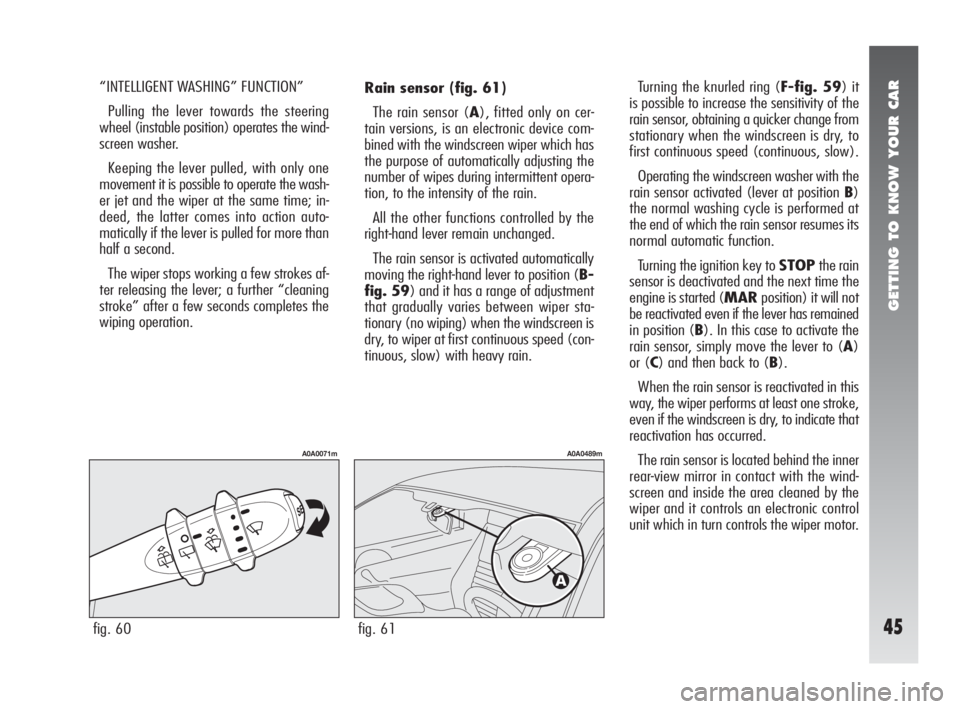
GETTING TO KNOW YOUR CAR
45
Rain sensor (fig. 61)
The rain sensor (A), fitted only on cer-
tain versions, is an electronic device com-
bined with the windscreen wiper which has
the purpose of automatically adjusting the
number of wipes during intermittent opera-
tion, to the intensity of the rain.
All the other functions controlled by the
right-hand lever remain unchanged.
The rain sensor is activated automatically
moving the right-hand lever to position (B-
fig. 59) and it has a range of adjustment
that gradually varies between wiper sta-
tionary (no wiping) when the windscreen is
dry, to wiper at first continuous speed (con-
tinuous, slow) with heavy rain.Turning the knurled ring (F-fig. 59) it
is possible to increase the sensitivity of the
rain sensor, obtaining a quicker change from
stationary when the windscreen is dry, to
first continuous speed (continuous, slow).
Operating the windscreen washer with the
rain sensor activated (lever at position B)
the normal washing cycle is performed at
the end of which the rain sensor resumes its
normal automatic function.
Turning the ignition key to STOPthe rain
sensor is deactivated and the next time the
engine is started (MARposition) it will not
be reactivated even if the lever has remained
in position (B). In this case to activate the
rain sensor, simply move the lever to (A)
or (C) and then back to (B).
When the rain sensor is reactivated in this
way, the wiper performs at least one stroke,
even if the windscreen is dry, to indicate that
reactivation has occurred.
The rain sensor is located behind the inner
rear-view mirror in contact with the wind-
screen and inside the area cleaned by the
wiper and it controls an electronic control
unit which in turn controls the wiper motor. “INTELLIGENT WASHING” FUNCTION”
Pulling the lever towards the steering
wheel (instable position) operates the wind-
screen washer.
Keeping the lever pulled, with only one
movement it is possible to operate the wash-
er jet and the wiper at the same time; in-
deed, the latter comes into action auto-
matically if the lever is pulled for more than
half a second.
The wiper stops working a few strokes af-
ter releasing the lever; a further “cleaning
stroke” after a few seconds completes the
wiping operation.
fig. 60
A0A0071m
fig. 61
A0A0489m
Page 48 of 291
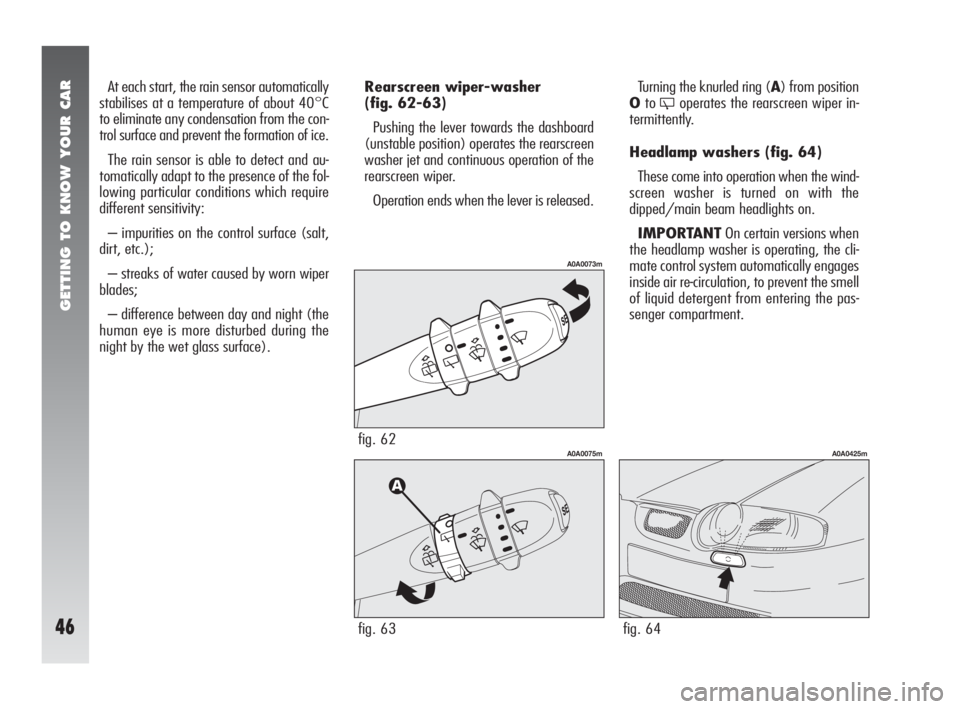
GETTING TO KNOW YOUR CAR
46
At each start, the rain sensor automatically
stabilises at a temperature of about 40°C
to eliminate any condensation from the con-
trol surface and prevent the formation of ice.
The rain sensor is able to detect and au-
tomatically adapt to the presence of the fol-
lowing particular conditions which require
different sensitivity:
– impurities on the control surface (salt,
dirt, etc.);
– streaks of water caused by worn wiper
blades;
– difference between day and night (the
human eye is more disturbed during the
night by the wet glass surface).Rearscreen wiper-washer
(fig. 62-63)
Pushing the lever towards the dashboard
(unstable position) operates the rearscreen
washer jet and continuous operation of the
rearscreen wiper.
Operation ends when the lever is released.
fig. 62
A0A0073m
fig. 63
A0A0075m
Turning the knurled ring (A) from position
Oto
'operates the rearscreen wiper in-
termittently.
Headlamp washers (fig. 64)
These come into operation when the wind-
screen washer is turned on with the
dipped/main beam headlights on.
IMPORTANTOn certain versions when
the headlamp washer is operating, the cli-
mate control system automatically engages
inside air re-circulation, to prevent the smell
of liquid detergent from entering the pas-
senger compartment.
fig. 64
A0A0425m
Page 49 of 291
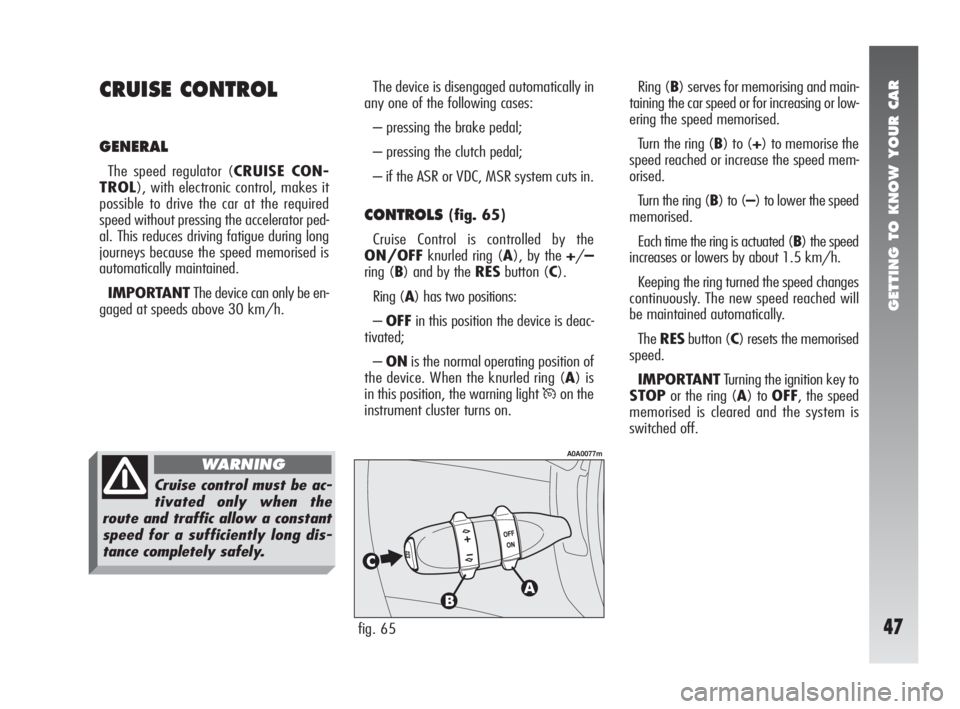
GETTING TO KNOW YOUR CAR
47
The device is disengaged automatically in
any one of the following cases:
– pressing the brake pedal;
– pressing the clutch pedal;
– if the ASR or VDC, MSR system cuts in.
CONTROLS(fig. 65)
Cruise Control is controlled by the
ON/OFFknurled ring (A), by the +/–
ring (B) and by the RESbutton (C).
Ring (A) has two positions:
–OFFin this position the device is deac-
tivated;
–ONis the normal operating position of
the device. When the knurled ring (A) is
in this position, the warning light
Üon the
instrument cluster turns on.Ring (B) serves for memorising and main-
taining the car speed or for increasing or low-
ering the speed memorised.
Turn the ring (B) to (+) to memorise the
speed reached or increase the speed mem-
orised.
Turn the ring (B) to (–) to lower the speed
memorised.
Each time the ring is actuated (B) the speed
increases or lowers by about 1.5 km/h.
Keeping the ring turned the speed changes
continuously. The new speed reached will
be maintained automatically.
TheRESbutton (C) resets the memorised
speed.
IMPORTANTTurning the ignition key to
STOPor the ring (A) to OFF, the speed
memorised is cleared and the system is
switched off.
CRUISE CONTROL
GENERAL
The speed regulator (CRUISE CON-
TROL), with electronic control, makes it
possible to drive the car at the required
speed without pressing the accelerator ped-
al. This reduces driving fatigue during long
journeys because the speed memorised is
automatically maintained.
IMPORTANTThe device can only be en-
gaged at speeds above 30 km/h.
fig. 65
A0A0077m
Cruise control must be ac-
tivated only when the
route and traffic allow a constant
speed for a sufficiently long dis-
tance completely safely.
WARNING
Page 50 of 291
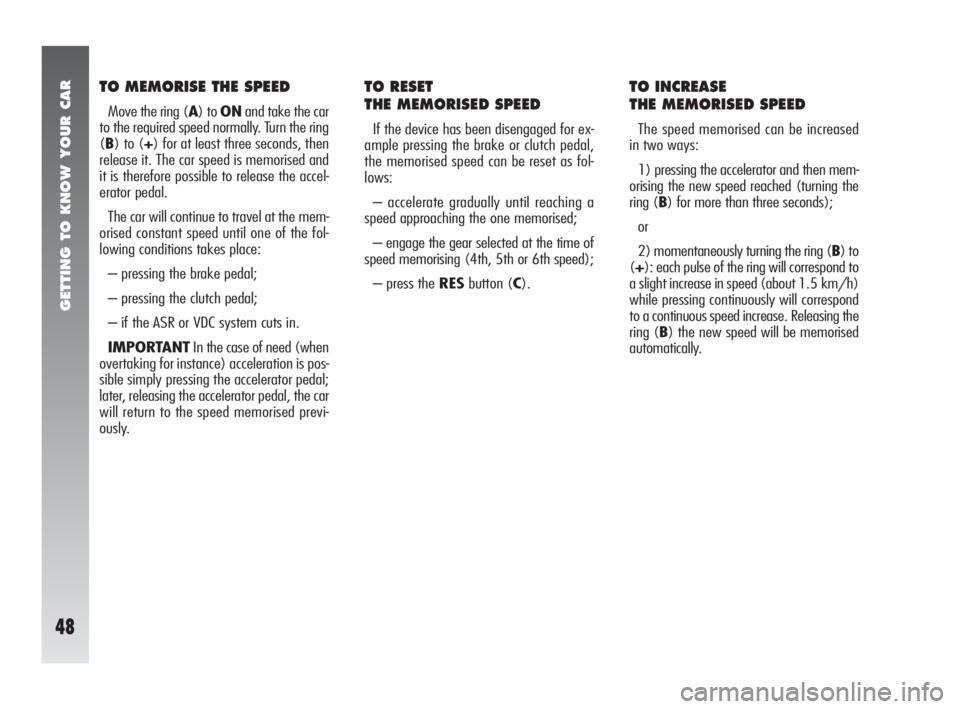
GETTING TO KNOW YOUR CAR
48
TO MEMORISE THE SPEED
Move the ring (A) to ONand take the car
to the required speed normally. Turn the ring
(B) to (+) for at least three seconds, then
release it. The car speed is memorised and
it is therefore possible to release the accel-
erator pedal.
The car will continue to travel at the mem-
orised constant speed until one of the fol-
lowing conditions takes place:
– pressing the brake pedal;
– pressing the clutch pedal;
– if the ASR or VDC system cuts in.
IMPORTANTIn the case of need (when
overtaking for instance) acceleration is pos-
sible simply pressing the accelerator pedal;
later, releasing the accelerator pedal, the car
will return to the speed memorised previ-
ously.
TO RESET
THE MEMORISED SPEED
If the device has been disengaged for ex-
ample pressing the brake or clutch pedal,
the memorised speed can be reset as fol-
lows:
– accelerate gradually until reaching a
speed approaching the one memorised;
– engage the gear selected at the time of
speed memorising (4th, 5th or 6th speed);
– press the RESbutton (C).
TO INCREASE
THE MEMORISED SPEED
The speed memorised can be increased
in two ways:
1) pressing the accelerator and then mem-
orising the new speed reached (turning the
ring (B) for more than three seconds);
or
2) momentaneously turning the ring (B) to
(+): each pulse of the ring will correspond to
a slight increase in speed (about 1.5 km/h)
while pressing continuously will correspond
to a continuous speed increase. Releasing the
ring (B) the new speed will be memorised
automatically.